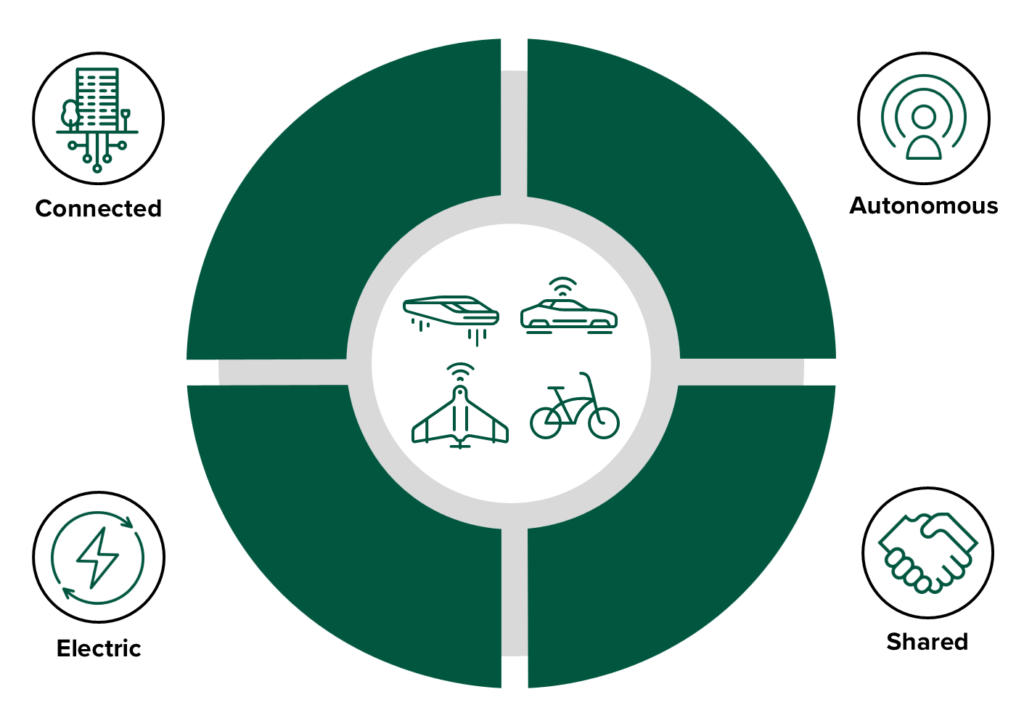The Future Of Mobility Will Be Connected, Autonomous, Shared, Electric — And More
Executives in the automotive sector spent a lot of the past decade talking about cars that would be connected, autonomous, shared, and electric (CASE, sometimes ACES). Unsurprisingly, connectivity is less interesting to consumers than what they might do with it, full autonomy on public roads is hard, ride sharing hasn’t been wholeheartedly embraced, and the rate of electric vehicle (EV) adoption has slowed in many markets.

But maybe those auto execs were on to something. Instead of focusing attention on building a car that is CASE, things become a lot more interesting (and plausible) if we think about the value of making the whole mobility ecosystem CASE. That’s exactly what a cross-disciplinary team here at Forrester has been doing, and two reports based on that work have just been published.
Forrester’s New Research Series On The Future Of Mobility Has Now Launched!
In The Future Of Mobility Will Be Connected, Autonomous, Shared, Electric — And More, we discuss external trends affecting three broad types of mobility: personal mobility (moving individuals or small groups of people), mass transit (moving large numbers of people), and the movement of goods (short- or long-distance movement of cargo). Those external trends include themes like sustainability, post-COVID changes in mobility patterns, and a growing interest in seamless experiences more aligned to the customer’s mobility moment than to the vendor’s product. The report then builds on that final theme, stressing that the future of mobility must focus more on the mobility and less on the tech. For example:
Innovators in mobility use technology to do some amazing things: Concorde used to whisk passengers from New York to London in less than 3 hours; more than 500 self-driving taxis transport paying passengers around Wuhan; drones deliver mail to several of Scotland’s islands; and Maersk cut the fuel consumption of one tanker by 8% after fitting her with high-tech sails. But Concorde was noisy and not economically viable; Baidu’s taxis in Wuhan are heavily subsidized; Royal Mail suspended deliveries in the Orkney Islands after a drone sank in the sea off Hoy; and Maersk sold the Pelican to an Indonesian shipping company. To secure real advances in mobility, technological innovation isn’t enough. New offerings must pull together a range of stakeholders capable of ensuring that products work in real-world environments (including real-world weather), are cost-effective and reliable at real-world scale, and play a useful role in the journeys of people living real (and complex) lives.
In Adapt Personal Mobility Ecosystems To New Customer Expectations, we focus on the first of our three broad types of mobility: the movement of individuals or small groups of people. This report explores the relationship between personal mobility and each of connectivity, autonomy, shared mobility, and electrification. It highlights some early successes and discusses the challenges that prevent these from scaling more broadly. Organizational silos, and insufficient focus on addressing the real customer need, emerge as more prominent barriers than you might have assumed.
Three more reports will follow the two we just published. There will be one each for mass transit and the movement of goods, then one will explore how changes to the mobility sector will play out over the short term (two to three years), medium term (five to 10 years), and longer term (over 10 years), with Forrester’s predictions on the innovations we should expect to see gain traction. We also have our report on the state of autonomous mobility technologies, an on-demand client webinar on the future of mobility, and plans for much more.
As always, if you have your own perspectives to share, please schedule a briefing and tell me all about them. If you’re a Forrester client and want to discuss (or challenge) my thinking on this topic, please schedule an inquiry.
